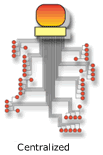 Device Level Interoperability Device Level Interoperability
Any discussion of interoperability should begin with a definition of what it means. Simply, interoperability in an automation network is defined as the ability of devices from one manufacturer to understand and use data from another manufacturer’s device regardless of sub-system types or original purpose without the intervention of very costly gateways or protocol converters.
The benefits made possible by interoperability are many. Automation systems get simple (re: more reliable) since one sensor or device can be shared among many different sub-systems. They also get cheaper as fewer sensors/controllers are needed in the system and costs drop appreciably as parts are reduced and installation time and complexity decrease. Lastly, more can be done with an automation network when the devices are interoperable. For example, in response to access control reader data and daylight illumination sensors, the HVAC and lighting systems can automatically adjust the comfort and illumination levels in pertinent work areas based on individual preferences and energy costs. Lighting can be adjusted on a cubicle-by-cubicle basis for computer operators and occupants near windows- either automatically or through commands entered from a user’s PC via the corporate LAN. Heating and air conditioning can by similarly tailored.
Network Operating Systems
One way to look at a network operating system (NOS) is to look at the benefits derived from having one. In the case of automation systems for facilities, these can be many. At the installation stage, an NOS allows multiple sub-system installers to work simultaneously rather than sequentially. For instance, a lighting system could be commissioned at the same time as an HVAC system. An NOS also gives manufacturers a software architecture for creating simple plug-ins that allow integrators to easily see and configure various aspects of a device or system such as temperature set points or schedules.
After commissioning has been completed and the facility is operational, the NOS plays a vital role in providing network information including device health, operating characteristics, maintenance information and energy demand. The data is available for presentation through a variety of Human/Machine Interfaces (HMI) that can disseminate this information through client-server based architectures (e.g., Wonderware’s Intouch). The pervasiveness of the Internet now enables this information to be shared through any web aware client, driving down costs and greatly increasing value. Time critical actions can now be affected as the NOS allows remote access to the automation network to such an extent as to allow facility managers or integrators to perform the exact same tasks that they could if they were locally plugged into the network.
[BACK]
Copyright Echelon Corporation |

